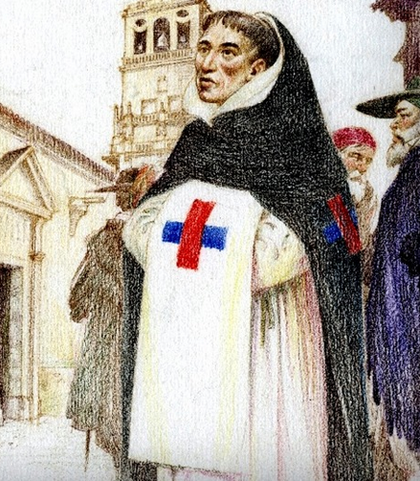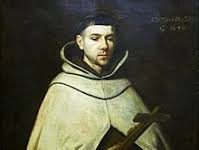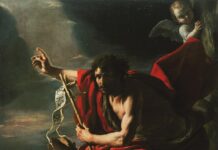
Most of us are familiar with the names John of the Cross and Teresa of Avila. They defined the Spanish Golden Age of mysticism and started the Reformation movement not just for their Order (Carmelites), but for the entire religious life of the Church. But there is another great reformer born in the same milieu, John (Juan) Garcia-Lopez Rico known as Fraile Juan Bautista de la Conception – St. John Baptist of the Conception. His feast day on February 14 is usually overshadowed either by St. Valentine or in this year, Ash Wednesday. Nonetheless, let us, in a quick gloss, see the heroic life of this great reformer and the impact he left to his spiritual sons and daughters known today as the Trinitarians.
Juan was born on the 10th of July 1561 at the height of the religious revival in Spain. He was raised in an upper-middle-class Catholic family and was trained in faith at an early age. His Father, Marco Lopez, was a cousin of another great Spanish saint, John of Avila, and his mom Isabella, as he described, was a pious and devout woman. It is no surprise then that three out of eight children pursued the priesthood and the religious life, Francisco who became a diocesan priest, Francisca who later entered the Carmelite convent, and of course, Juan a Fraile Trinitario and a great reformer of the Trinitarians.
His early years were marked with academic excellence and passion for rhetoric and language. He was tutored by the Carmelite brother Augustino del Reyes who recommended him to pursue liberal arts at the University of Baeza. After finishing it in two years, he moved to the University of Toledo to study theology where he encountered the works of the great Trinitarian scholar Robert Gauguin. It is here at the University that John discerned his vocation to be a Trinitarian.
A year later, John entered the novitiate and consequently made it to simple profession taking the name Fraile Juan Bautista – Brother John Baptist. He continued his study of theology and by 1585 was ordained a priest. Known for his eloquence in preaching, John was appointed as the official preacher of the Order in 1589. His popularity spread like wildfire in Seville, Aragon, and Ciudad de Real meriting the title “The Great preacher of Penance and Eucharist.” It is said that there are no dry eyes in the pews every time he speaks, and right after he says Mass, most of them, if not all, go to confession.
In 1594, a recollect Trinitarian movement started in the provinces of Andalusia, Aragon, and Castille. It is a group of friars aspiring to live the primitive rule of St. John de Matha. Fr. John Baptist, who at this time was gaining more and more popularity with his preaching, decided to enter this reform upon his eventual experience on his way to “Andujar” (Jaen).
In his journal, he describes this experience as a mystical call from God. “I have always wanted to join the recollect movement, but I am afraid of my health and my capacity to live the primitive rule. I asked God to give me a sign if this is his will for me, and if it is, let it be done so.” On his way to “Andujar” (Jaen) John fell from his mule and a heavy storm of hail and thunder almost killed him. He begs God that if it is his will that he joins the recollect, he will survive this storm, but if not, he is ready to meet his death. Surprisingly, after this prayer, the storm stopped and there was a clear sky. John, therefore, saw this as a clear response from God that he wants him to be in this recollect movement.
The Reform
John joined this small group of friars aspiring to primitive Trinitarian life in Valdepeñas. Two months later, he was elected as the first superior and he started to formally enforce the primitive rule of St. John de Matha. This includes 6-7 hours of meditation and communal prayer, 3-4 times a week of fasting and abstinence, and a more intensive missionary work to the poor, the sick, and the homeless.
Sadly, this way of life was seen to be extreme and the small of group friars started to retaliate against John and left. He received severe criticism from the other religious communities in Valdepeñas and from his very own Trinitarian brothers accusing him of “dividing” the Order. He was also beaten several times by Spanish Trinitarians accusing him of being “self-righteous” and “evil.” On his way to Rome, some Italian Trinitarians poisoned him preventing him to submit his proposal of the recollect (reformed) movement to the Holy Father.
He survived all of it but became exhausted. He writes in his journal “I wanted to think that God has abandoned me, and that all these things are but in vain, nobody seems to be on my side, and everything is falling apart.” John took shelter with the Carmelites in Rome but things got even worse. The Italian Trinitarians who initially poisoned him spread false rumors to the Roman Curia telling that this “John who asks permission to establish a reformed community is a drunkard and a friend of prostitutes and thus not worthy of such responsibility” They even hired someone to torture him to send him the signal that if he continue to pursue his request to the Holy Father, he will die a brutal death.
This became a little too much for John and he almost lose his faith. he writes “I do not know if God is still with me in this endeavor, everything is overwhelming me now and I cannot see the light” However, he would go back to his senses and write while weeping “My profession of faith as it is, I believe in Almighty God, I believe in all that which our Mother the Church holds and believes. And if at some time I say or think something to the contrary, I say that I would be speaking falsely and I would not be what I claim.”
The Approval
On August 20, 1599, Clement VIII approved the proposal of John and called it the “Congregation of the Reformed and Discalced Brothers of the Order of the Most Holy Trinity.” John sets out to Madrid bearing the Papal Bull and inflamed to found houses of the reformed, or by this time called the “Discalced” movement. He reached Spain and presented himself to the Nuncio which appointed an Apostolic Visitator (Someone who guides and evaluates the initial works of this new movement) Fr. Elias of St. Martin to work with John for the two next years.
Then it was on the solemnity of the Immaculate Conception that John Baptists entered as the first novice of this newly found Discalced Trinitarian and assumed a title that reflects his intimate devotion to the Blessed Mother, Fraile Juan Bautista de la Concepcion – John Baptist of the Conception.
The New Era Begins
Brother John Baptist of the Conception started establishing houses of mercy and monasteries following the primitive rule of St. John de Matha. His way of life, though rigid in the eyes of his contemporaries, attracted more vocations than any other religious orders in Spain. After some more years, John secures the status of “Province” having been able to found eight houses in the span of a decade. By 1611, there are at least more than ten houses of the Discalced Movements and over fifty members both seminarians and professed. By the end of the 17th century, the number of Discalced exponentially grew outnumbering the “Calced Trinitarians”
The Trinitarians today takes it root from this foundation of John Baptist of the Conception making the entire Trinitarian family a spiritual sons and daughter of Sts. John de Matha, St. Felix, and St. John Baptist of the Conception.
Death and consequent miracles
After years of working for the Church and for the Order, the reformer set out to Cordoba for his final trip. In his final days, John spent his time in prayer writing in his little journal he says “Lord, I almost die from uremic poisoning and stitches on my side which I endure with great happiness and consolation since I suffer love of you, Lord you know well that I have done all that I could”
On February 14, 1613, at 2:55 in the afternoon, the brothers gather around John and starts intoning the Credo. In tears, John asked forgiveness and blessing from his brothers and after a brief prayer each brother kissed his hand bidding their one last farewell.
Then with a weak attempt he instructs his sons saying: “My sons do not trouble yourself for I will serve you more in heaven” Then in the last minutes of his agony, he started breathing exhaustively, fixing his eyes on the cross then exclaimed one last deep breath and cried “I love you O Lord, and yon know that I have done all that I could” and closed his eyes. It was exactly 3:00 p.m., Juan Bautista de la Concepcion went into eternal life.
Few years later, miracles of healing and heroic virtues were compiled by the Discalced Trinitarians. In 1679 all of his writings were collected and sent to Rome for examination, in 1726 they were found to be free of any forms of heresy and with that John Baptist of the Conception was declared Venerable. More and more miracles were attributed to his intercession and in 1819 at the pontificate of Pius VII, he was beatified. Many more miracles were attested in honor of this beloved son of God and so on the 25th of May 1975, by decree of Pope Paul VI, Blessed John became San Juan Bautista de la Concepcion – St. John Baptist of the Conception.
St. John Baptist of the Conception today remains to be the great pillars of the Order of the Most Holy Trinity and of the Captives. The foundation that he started remains to be the rock where all Trinitarians today stand.
St. John Baptist of the Conception, Pray for Us!
Pujana, Juan O.SS.T. St. John Baptist of the Conception translated by Rev. Brendan Gross, O.SS.T. Rome: 1975.
General Secretariat Order of the Most Holy Trinity and of the Captives. Saints John de Matha and John Baptist of the Conception. Rome 2013.
D’errico, Anthony, O.SS.T. The Trinitarians An Overview of their Eight Hundred Year Service to God and Humaniy. Baltimore: Trinitarian Publications, 2008.










